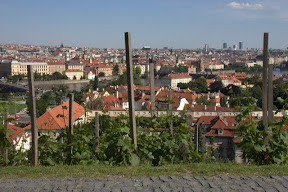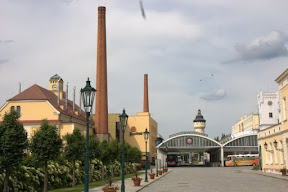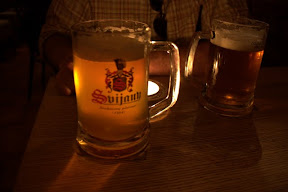Whirlwind Weekend in Munich
Even though I had only seen her once since we graduated from college, my friend Abbie generously hosted us at her apartment for a weekend in Munich. Thanks to the wonders of Facebook, I knew that Abbie moved to Munich a year ago to work as a scientist. (Isn’t it fun to say that someone is a scientist? And she really is). I thought it would be fun to see her and to take a little foray into Germany en route from the Czech Republic to Slovenia. The whole weekend was a whirlwind, starting with us blowing into Munich Friday afternoon and ending with us blowing out of Munich Monday morning, complete with a mad dash to jump on the train only seconds before it started moving.
| From Munchen |
In between those times, we had a lot of fun hanging out with Abbie and hearing about her new German lifestyle. She passed on some of the insights about Germany that can only be gained from living there instead of just passing through. It was nice to have our own personal tour guide. She made sure that we got a proper tour of Munich, which included visiting a beer garden, walking through Englischer Gardens, seeing Munich’s may pole (a giant pole neighboring towns used to steal from each other), and rubbing the well worn noses of three lions outside a palace for good luck. On Saturday, we hit the autobahn in Abbie’s car to visit the Dachau Concentration Camp Memorial Site (more on that later) and a monastery with tasty beers brewed by monks. (We learned, by the way, that there is no such thing as The Autobahn, just many autobahns).
As we walked around Friday evening, it seemed the whole city was abuzz. The late day sun was still shining, and apparently it had been the first really nice day in ages.
Hailing from Pittsburgh, of course I love rivers. One of my favorite things about Munich was the river was so accessible to everyone. It ran right through Englishcher Gardens (what we would call a park) and was almost like a big stream. Although Germans apparently have a lot of rules, we learned that they don’t always follow them, as demonstrated by the groups of teenagers frolicking in the water close to a sign forbidding swimming in the river. (Including one group of three boys signing Take Me Home, Country Roads by John Denver, despite being a long, long way from West Virginia).
In the grassy areas next to the river banks, kids were taking advantage of Germany’s lax alcohol laws to throw a riverside party.
Further on down the river, we watched the river surfers navigate the rushing waters on their surfboards.
Bikes are prevalent everywhere in Europe, but it seemed everyone had a bike in Munich. People sailed past us on their bicycles, dinging their bells so we would get out of their way. No matter how many times I accidentally walk in the bike path, much to the chagrin of bikers worldwide, I always have a delayed reaction to the dinging bells.
We had visited a beer garden in Prague, but it felt more like we were crashing someone’s backyard cookout than a public gathering place. Munich’s beer gardens are notorious places, always situated under big chestnut trees, with big crowds drinking giant 1 liter beers. We ate pretzels, currywurst, and a cheese dip at what Abbie said was a proper beer garden: one with long benches and shared tables, covered with chestnut trees, where you could bring your own food if you choose to do so.
And of course we drank giant beers (we are both German, after all), and learned the proper way to cheers someone.
Besides the good weather, we suspected that everyone’s good moods had something to do with it being the opening weekend of the World Cup. The soccer fever was everywhere.
Most of the cars and houses proudly displayed German flags. We watched the United States tie England at a cookout at Abbie’s apartment with her group of friends, a fun crowd hailing everywhere from Germany to Portugal to New Zealand. Their excitement over the World Cup was contagious. There was a mixed group in terms of who was rooting for and against the United States, mostly due to whether a US win would benefit their fantasy soccer teams or not.
Being avid American football fans, it wasn’t hard for us to get into the World Cup, so we tried to learn as much as we could from Abbie and her friends to prepare us for the next month. Like most Americans, we know very little about professional soccer. I think Abbie’s friend Katrin is right: without commercial breaks, soccer will never make it big in the United States. I will say, although the commercial breaks during football games at home border on the absurd at times, it is nice to have one now and again for a bathroom break, particularly when drinking giant beers. (Seriously, it is easy to get quite tipsy when you are drinking beers by the half liter, as many of the German beers come. I find it amusing that when Germans feel they have had too much to drink, they don’t stop drinking or start drinking less. Instead, they just water down their beers with lemonade – a tasty drink known as a Radler). The next night, we watched Germany beat Australia 4-0. Even to our novice eyes, we could tell that the German players had much fancier footwork than the American players.
And of course I would be remiss to mention three other favorite aspects of the weekend: Abbie’s homemade chocolate chip cookies, Floyd, and Mr. Monk.
Thanks, Abbie, for giving us a window into life in Munich and for sharing your stash of imported chocolate chips and your kitties.
Exploration
Spending eight days in Prague meant that we had a fair amount of time to explore the city. As it was, there were still more we could have done. I never quite was able to talk Sean into going paddle boating in the river, for instance. The holy grail for any traveler is finding places where you are the only tourist in the room, without feeling like you are invading the local people’s secret place. Of course, being that you are a tourist yourself, you never can quite achieve this all of the time. Not that you necessarily would want to – there is a reason why there are hundreds of people walking across the Charles Bridge or touring Prague’s two castles. (Which, by the way, are more fortifications rather than castles. I have yet to fulfill seeing the Disney-like image of a castle I have in my head in real life). But sitting in a restaurant surrounded by people who are from anywhere but the present location, eating food that someone deemed tourists would like and pay money for, is typically not our cup of tea.
So to help us find interesting places outside our guidebook, we relied heavily upon the website Spotted by Locals. A friend of our friends in Paris told us about it while we were there, but Prague was the first time we checked it out in a more in depth fashion. The whole premise of the website is to spread the spotter’s love of their cities with visitors by sharing their favorite places. You can read the entries online for various cities across Europe, or download a city guide to use offline.
Some of the places are ones that we already knew about or would have found anyway, such as the walkway by the river with views of the Castle, or Lennon’s wall, but the suggestions often gave us a different perspective when visiting.
Others overlapped with recommendations from our hotel, such as Bio Zaharda, a cool organic coffee shop, or Clear Head, one of the best vegetarian restaurants we have been to any where in the world.
Many of them were things we may not have known about otherwise: the French patisserie St. Tropez, tucked away in a shopping complex; the intimate coffee shop Al Cafetero, where we had delicious small meals and coffee from a vacuum pot; or the little Italian cucina Osteria da Clara, where we had our anniversary dinner. (Incidentally, I am convinced that Italian is better the closer you get to Italy; must eat my way through Italy someday).
Of course, nothing beats wandering across a funky or cool place all on your own. Maybe it is something undiscovered by tourists, maybe it is something you just happened to miss when reading about the city. Either way, you never know what you might find: a chill neighborhood bar; a vineyard with surprisingly good wine and excellent views of the city; or a peaceful park with meandering peacocks.
Prague in pictures (aka we took 310 pictures in Prague, somebody has to look at them).
Rainy weather at Lake Bled…
…means blog improvements. Check out the new FAQ section at the top. I’ve also added an email subscription form on the side, so please subscribe if you would like an email each day that the blog is updated (except for those procrastinators who actually prefer to manually check back multiple times in a day, not that I would have ever known anyone like that). I hope to add something to the blog soon that updates our current destination (currently, Slovenia). Thanks for reading!
In which we drink lots of beer. And eat pig’s knee.
The good part about Prague’s food is that it goes perfectly with beer. The bad thing is that it is notoriously short on veggies and very heavy. To my untrained stomach, it is similar to German food, but…different. There is always a ton of meat. It is best to stick with beef or pork. I ventured over to chicken for one meal, which was a mistake. I also accidentally ordered the largest piece of pork I’ve ever seen short of an entire pig at a pig roast. And apparently it was a pig’s knee. What can I say, I liked the sauce description. Turns out eating pig’s knee is common in the Czech Republic (and Germany for that matter) and it doesn’t taste half bad.
We like the goulashes a lot, and my favorite meal was beef in “candle sauce” (a creamy, lemony, cranberry type sauce).
I don’t mind the sauerkraut, which shocks me. Sean keeps trying to tell me that sauerkraut counts as a vegetable, but I don’t buy it. Maybe the red cabbage. There are always a lot of potatoes in some form. The kvednicky (dumplings) are delicious and soaks up all of the beers we drink.
Look, veggies!
For the last two months, we have been mostly in countries that feature wine as their specialty. I forgot how much I loved beer until we arrived in Prague. It had been a while since I had a good beer, one from the tap with a thick, foamy head on the top. That seems to be par for the course in Prague.
Beer is everywhere in Prague, and due to European’s apparent reluctance to drink water out of the tap, indeed sometimes cheaper than water. They even have beer vending machines.
Did you know that there is a beer in the Czech Republic that is called Budweiser (or Budvar in Czech) and it is much more delicious than Budweiser at home? I did not know this until we had some in Paris. They are two different companies. It is not fair that we get stuck with the crappy Budweiser. We have had some giant, foamy Budvars since our arrival.
Budvar’s biggest competitor in the Czech Republic is Pilsner Urquell, a beer Americans are more familiar with. The original Pilsner Urquell brewery is in Plzen, which is an hour and forty minutes from Prague by train. We ventured to the brewery, and saw the bottling process, tasted hops, malt and barley, saw the copper vats where the beer is brewed for 5 weeks, and tasted an unfiltered beer from their special cellar. We enjoy drinking cask beer at home, which is served at a higher temperature. Perhaps that is why we enjoyed the Czech beer, because it is served at a higher temperature than most Americans are used to. The best beers here have been the ones on draught served unfiltered and unpasteurized. Apparently they have more vitamin B that way, which is a bonus. I am probably lacking essential vitamins due to the lack of vegetables.
Here are our three favorite places we drank beer in Prague:
(1) Breaking my normal rule of no chains, we ate and drank one night at The Pub, which is a Czech chain with several locations in Prague and smaller cities. At the Pub, you can pour yourself an unfiltered Pilsner Urquell from the tap at your table. The computerized screen automatically displays how much beer you have poured, and also shows your tally on a large screen for the whole room to see. The screen displays the top ten tallys for the restaurant, as well as a separate top ten for all of the Pub’s locations. Our immediate thought was, [our friend] Stayduhar could totally crush this competition. As a table of two, we never made it to the top ten of all of the locations, but we are proud to say we stayed on the board for the Praha 1 location. Thank goodness for public transportation.
(2) On our way back to our hotel from metro after our visit to The Pub, we happened across a little bar up the street from our hotel. You want to go in? I said. Sure, Sean replied. What’s one more beer? It was immediately obvious this place did not get many tourists. Lit by candlelight, with David Bowie in the background, you could tell that this was the type of place people came to chill. And chill people did, including the people at the table behind us, who were passing a joint around their table. Spying the unfiltered beers on the menu, we gave more specificity than normal when we ordered, requesting two beers, large, unfiltered. Right, the bartender said. So you mean two beers. Regular beers. They were large, foamy, and delicious. Sean’s one turned into two. When we went to pay, we misheard the bartender and thought he said 180 Czech crowns, an amount which would have been around $8.50 for three half liter beers. No, said the bartender. I said 108. (Around $5 USD). 180? He laughed. That would be expensive. Right. Expensive.
(3) I would have to put the Pivovarsky Klub on the list for its awesome name, even if it didn’t turn out to be as cool as it was. A little off the normal tourist track in Karlin, it was visited by Anthony Bourdain in the Prague episode, and also mentioned on the blog SpottedbyLocals.
Somewhat inadvertently, we also ended up visiting its sister restaurant Pivovarsky Dum, which is a microbrewery.
The beer is great at both places, but we preferred the food at the Pivovarsky Klub. The Pivovarsky Klub has six beers on draught. At least one will be from its sister restaurant, and most of the others are a good sampling of other types of Czech beer besides Pilsner Urquell and Budvar. They also have tons of bottled beers from all over the world. (The American representatives, if you are curious, are Sam Adams and Sierra Nevada). This wide variety of beer might not be unusual in the United States, but in Europe, there is typically only have one or two choices on tap, making ordering beer as simple as saying, two beers, please.








































